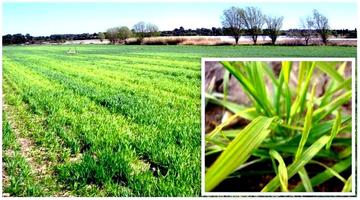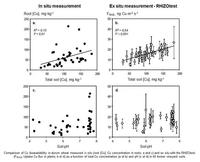Copper phytotoxicity in grapevine growing areas
The protection of grapevines by repeated copper-based fungicide use is known to contaminate soils with copper. In the Languedoc-Roussillon region, where 150,000 ha of vineyards have been pulled up and replaced by durum wheat crops, that soil contamination has led to the appearance of copper phytotoxicity symptoms in the form of iron chlorosis in durum wheat.
As copper phytotoxicity is acknowledged to be one of the main causes of yield reductions in durum wheat grown on soils with a previous grapevine crop [1], it has proved necessary to estimate transfer from the soil to the plant, i.e. the phytoavailability of copper, in order to assess phytotoxicity risks. Copper phytoavailability was therefore estimated in the laboratory using a biotest, the RHIZOtest, and a physico-chemical method, such as measuring copper speciation in the soil solution. The results were then compared to some reference measurements carried out directly on durum wheat grown in the field.
Surprisingly, the copper phytoavailability measured in the field was not correlated to the soil pH but, conversely, it could mainly be correlated to the soil’s total copper content. While the measurements taken with the physico-chemical method could mainly be correlated to the soil pH, the phytoavailability measurements taken with the RHIZOtest followed the trends observed in the field [2, 3].
The RHIZOtest therefore proved to be able to discriminate soils based on the copper phytoavailability criterion by being sensitive to the same physico-chemical properties of the soils as those to which the reference measurements were sensitive in the field. These results therefore show the merits of the RHIZOtest for assessing the phytoavailability of trace elements in contaminated soils .
1. Braun P, Gilbert E et Mura V 2002 En région méditerranéenne: Diagnostic des accidents du blé dur. Perspectives Agricoles 285, 78-81.
2. Bravin MN 2008 Processus rhizosphériques déterminants la biodisponibilité du cuivre pour le blé dur cultivé en sols à antécédent viticole. Spécialité : Ecosystèmes, Montpellier SupAgro, 204 p.
3. Bravin MN, Michaud AM, Larabi B et Hinsinger P 2010 RHIZOtest: A plant-based biotest to account for rhizosphere processes when assessing copper bioavailability. Environ. Pollut., 158, 3330-3337.


